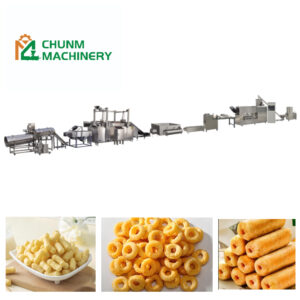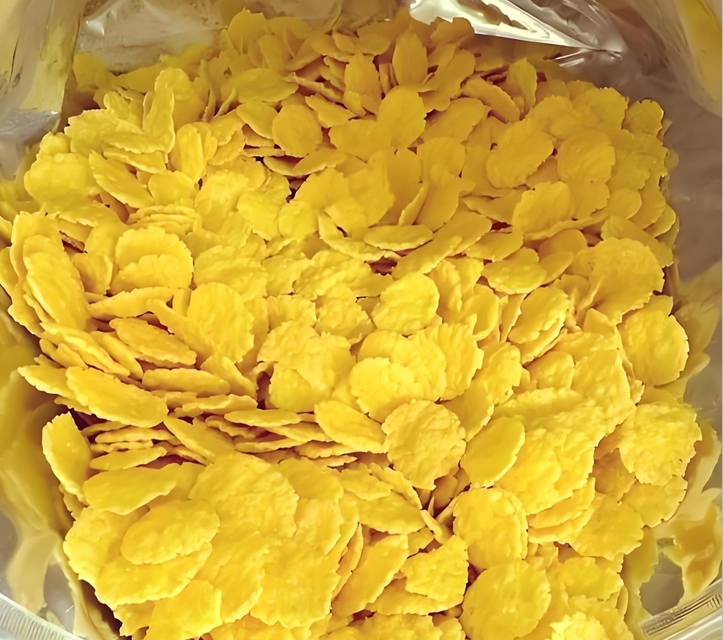
The Manufacturing Process of Corn flakes: From Kernel to Crispy Delight
Corn flakes, a popular snack enjoyed worldwide, are known for their satisfying crunch and versatility. While recipes can vary between brands, the industrial production process follows a consistent series of steps to transform simple corn kernels into the uniform, shelf-stable chips we find in stores.
1. Ingredient Selection and Preparation
The primary ingredient is, of course, corn. Specifically, manufacturers use whole kernel corn or, more commonly, degerminated yellow corn meal. Using corn meal ensures consistency in flavor and texture. The corn is carefully inspected and cleaned to remove any foreign materials like husks, stones, or dust.
Other ingredients include:
Water:Used for hydration and mixing.
Vegetable Oil: For frying (or spraying for baked varieties). Common oils include corn, sunflower, or canola oil.
Salt: Added for flavor.
Seasonings and Flavors:Such as cheese powder, chili, lime, or natural flavors, which are often applied after frying.
2. Masa Dough Production (Nixtamalization)
This is the most critical and distinctive step, originating from ancient Mesoamerican techniques.
Cooking and Steeping: The corn kernels are cooked in a solution of water and food-grade lime (calcium hydroxide). This process, called nixtamalization, softens the kernels, loosens the hulls, and importantly, makes the niacin in the corn nutritionally available. It also imparts the characteristic flavor and aroma that define traditional corn chips.
Washing and Draining:The cooked corn, now called nixtamal, is thoroughly washed to remove the loose hulls and excess lime.
Grinding:The cleaned nixtamal is ground into a soft, pliable dough called **masa**. The grind size is crucial; for chips, it is typically finer than for tortillas to create a denser structure.
3. Sheeting and Forming
The fresh masa is fed into a mixer where water and sometimes a small amount of oil are added to achieve the perfect consistency for sheeting.
The masa is then passed through a series of heavy rollers that form it into a thin, continuous sheet. The thickness of this sheet is precisely controlled, as it determines the final chip’s crunch and density.
This sheet of masa is then cut into specific shapes. For traditional triangular chips, a rotary cutter stamps out the distinct shape. The scrap masa from between the chips is recycled back into the mixer, ensuring minimal waste.
4. Baking (Pre-Cooking)
Before frying, the raw, formed chips undergo a brief baking process. They pass through a high-temperature oven for 15 to 20 seconds. This step:
Sets the chip’s structure.
Reduces its moisture content.
Helps create a blistered, bubbly surface texture.
Minimizes oil absorption during frying.
5. Frying
The pre-cooked chips are conveyed directly into a continuous fryer filled with hot vegetable oil (typically between 350-375°F or 175-190°C).
As they travel through the fryer on a submerged conveyor belt, the remaining moisture rapidly vaporizes, creating the chip’s light, crispy texture and golden-brown color. The frying time is precisely calculated to achieve the desired moisture content (typically below 2%) without burning.
Note: For “baked” corn chips, this frying stage is replaced with a longer baking process in a high-temperature oven. Oil is often sprayed onto the chips before baking to mimic the mouthfeel of fried chips.
6. Cooling, Seasoning, and Flavoring
After frying, the chips are conveyed out of the fryer and onto a long, open conveyor belt to cool and allow excess surface oil to drain.
As they cool, they pass under a **seasoning applicator**. This can be a drum that evenly dusts powdered seasonings (e.g., cheese, chili powder) onto the chips. For wetter seasonings, a slurry is sprayed on, and the chips may undergo a secondary drying stage.
7. Quality Control and Packaging
Optical scanners and manual inspectors check for broken, undercooked, or burnt chips, which are removed.
The chips are weighed and directed into packaging machines, which fill flexible bags made from multi-layered plastic film (often with a foil layer). This material is crucial as it provides an excellent barrier against moisture, oxygen, and light to protect the chips from becoming stale or rancid.
To preserve freshness and create the characteristic “pillow” of air in the bag (**nitrogen flushing**), the air inside the bag is replaced with inert nitrogen gas before sealing. This prevents oxidation and crushing.
8. Distribution
The sealed bags are then case-packed, palletized, and shipped to distribution centers and retail stores, ready to be enjoyed by consumers.
In conclusion, the production of corn chips is a fascinating blend of ancient food science (nixtamalization) and modern, high-speed automation. Each step is meticulously controlled to ensure every bag delivers the consistent taste, texture, and quality that snack lovers expect.

The Critical Role of Temperature Control in Corn Chip Manufacturing
Temperature control is a fundamental aspect of industrial corn chip production, acting as the invisible hand that governs everything from texture and flavor to shelf life and safety. Precise thermal management at each stage is what transforms simple ingredients into a consistent, high-quality snack. This article details the pivotal points of temperature control throughout the manufacturing process.
1. Nixtamalization: The Foundation of Flavor
The process begins with nixtamalization, where temperature is first critically applied.
Cooking:Corn kernels are cooked in an alkaline solution (water and lime) at temperatures between 85°C to 100°C (185°F to 212°F)**. This heat facilitates the chemical reaction that breaks down the corn’s hull and germ, making the kernels pliable.
Steeping: After cooking, the corn is left to steep for 8-16 hours. While this is often seen as a soaking step, maintaining a warm temperature (~50°C or 122°F) is crucial. This sustained warmth allows for complete hydration and the full development of the distinctive masa flavor and aroma. Letting the temperature drop too low can stall the process and lead to incomplete nixtamalization, resulting in a product with poor flavor and texture.
2. Masa Preparation and Sheeting
After washing, the nixtamal is ground into masa. The friction during grinding** generates heat. Operators must control this to keep the masa temperature within a range of 30-35°C (86-95°F)**. Masa that is too hot can become sticky and difficult to sheet, while masa that is too cold may not bind properly, leading to cracking.
3. Baking (Pre-Cooking): Setting the Structure
Before frying, the formed chips pass through a multi-zone oven.
Temperature:oven temperatures are typically set between 260°C to 315°C (500°F to 600°F).
Function: This intense, brief blast of heat (15-30 seconds) serves two key purposes:
1. It rapidly gelatinizes the starches on the chip’s surface, setting its structure and creating the characteristic blisters.
2. It reduces the moisture content from ~50% to ~8%, forming a stable “crust.” This is vital for the next step, as it prevents the chip from absorbing excessive oil during frying.
4. Frying: The Transformation to Crunch
The fryer is the heart of the operation, where temperature precision is non-negotiable.
Oil Temperature:** The oil is maintained at a constant **175°C to 190°C (350°F to 375°F)**. This range is scientifically chosen:
Too Low (<175°C / 350°F): The chip will fry too slowly. Instead of a rapid burst of steam creating a porous, crunchy texture, the chip becomes hard, dense, and greasy as it absorbs oil before the moisture can escape.
Too High (>190°C / 375°F):** The exterior burns before the interior moisture is fully driven out. This results in a bitter taste, darkened color, and an uneven texture—charred on the outside but tough and leathery on the inside.
Residence Time:The conveyor speed is synchronized with the oil temperature to ensure chips are submerged for the exact correct time (usually 60-90 seconds) to achieve the target final moisture content of less than 2%.
5. Oil Management: A Constant Balancing Act
Maintaining fryer temperature isn’t just about setting a thermostat. Continuous cooking lowers the oil temperature as cold product enters. The heating system must constantly compensate for this. Furthermore, oil quality degrades over time through oxidation and hydrolysis, a process accelerated by high temperatures. Therefore, monitoring and filtering the oil is essential to maintain its thermal efficiency and prevent off-flavors.
6. Cooling and Seasoning
Cooling: After frying, chips must be cooled on a conveyor before seasoning and packaging. If packaged while hot, residual heat would create steam within the bag, leading to sogginess and rapid rancidity. Forced air cooling brings the chips down to near ambient temperature.
Seasoning: The application of oil-based seasoning slurries must also be controlled. The slurry is often warmed to make it easier to spray evenly. If too cold, it won’t adhere properly; if too hot, the flavors can degrade.
7. Packaging: Locking in Freshness
The final critical temperature control point is during packaging. Chips must be cool before they are nitrogen flushed and sealed.
Nitrogen Flushing: The inert nitrogen gas is at room temperature. Replacing the oxygen-rich air with nitrogen prevents oxidative rancidity, a chemical reaction that accelerates with heat.

No related files found.
The company has fifteen years of experience and is committed to providing customers with the most cost-effective production line solutions
Copyright © 2025 JiNan Chunm machinery. All rights reserved. Privacy Policy